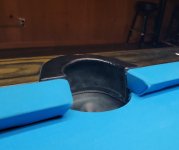What I meant by 'opposite' is exactly what you describe below:When you say 'opposite" on most of the tables you've seen, you're going to have to explain that, because for 40 years working on pool tables, all I've ever seen, and done, is put folds in the side pockets.
I had never seen the folds on the front side of rails before this streamed match up. It caught my eye immediately as odd. Didn't appear to be a point of contention regarding the event so I thought I'd post the observation here to see if this was a standard practice that I simply hadn't been exposed to yet.But, these fold are under rhe front of the rails, and though they look clean, they're the wrong way to finish the side pockets.
For a breif moment I was surprised it wasn't a topic for bitching on the main forum, but no one there really focuses on the physical aspects of equipment that actually matter.
